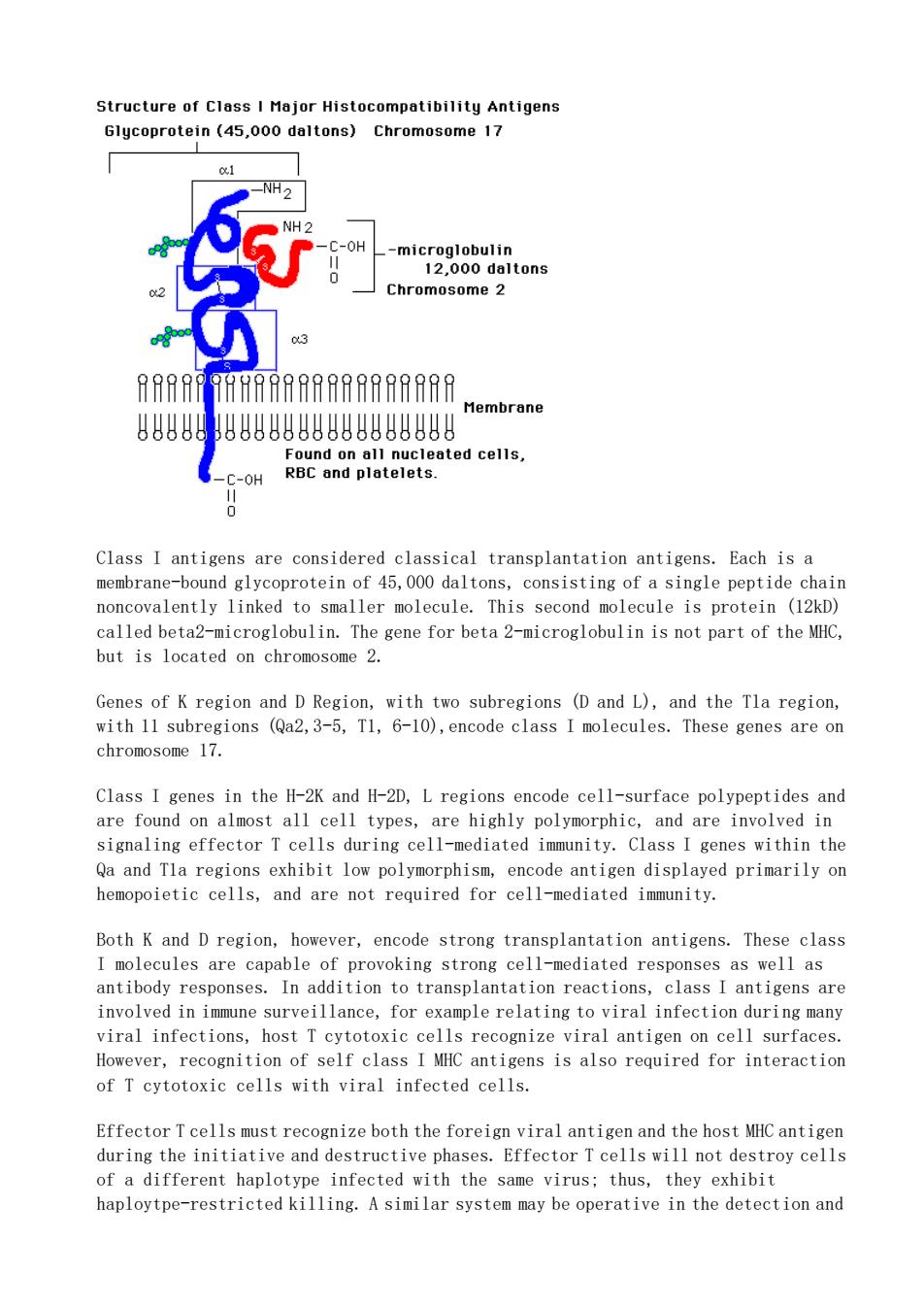正在加载图片...

Structure of Closs I Mojor Histocompatibility Antigen Glycoprotein (45,000 daitons)Chromosome 17 1 -micrg2a8intoans Chromosome 2 8999e99H99999999999999 Membrane AAABAA8A88AAA88A -OH 8c2dngpnl86lg6ateacels, Class I antigens are considered classical transplantation antigens.Each is a membrane -bound gly consisting of a single peptide chain noncovalently linked to smaller molecule.This second molecule is protein (12kD called beta2-microglobulin.The gene for beta 2-microglobulin is not part of the MHC, but is located on chromosome 2. Genes of K region and D Region,with two subregions (D and L),and the Tla region, with 11 subregions (Qa2,3-5,T1,6-10),encode class I molecules.These genes are on chromosome 17. Class I genes in the H-2K and H-2D,L regions encode cell-surface polypeptides and are found on almost all cell types,are highly polymorphic,and are involved in signaling effector T cells during cell-mediated immunity.Class I genes within the Qa and Tla regions exhibit low polymorphism,encode antigen displayed primarily on hemopoietic ells and are no required for cell-me diated immu nity Both K and D region,however,encode strong transplantation antigens.These class I molecules are capable of provoking strong cell-mediated responses as well as antibody responses.In addition to transplantation reactions,class I antigens are involved in immune surveillance,for example relating to viral infection during many viral infections,host T cytotoxic cells recognize viral antigen on cell surfaces However, recognition of self class antigens is also required for interaction of T cytotoxic cells with viral infected cells. Effector T cells must recognize both the foreign viral antigen and the host MHC antigen during the initiative and destructive phases.Effector T cells will not destroy cells of a different haplotype infected with the same virus:thus,they exhibit haploytpe-restricted killing.A similar system may be operative in the detection and Class I antigens are considered classical transplantation antigens. Each is a membrane-bound glycoprotein of 45,000 daltons, consisting of a single peptide chain noncovalently linked to smaller molecule. This second molecule is protein (12kD) called beta2-microglobulin. The gene for beta 2-microglobulin is not part of the MHC, but is located on chromosome 2. Genes of K region and D Region, with two subregions (D and L), and the Tla region, with 11 subregions (Qa2,3-5, T1, 6-10),encode class I molecules. These genes are on chromosome 17. Class I genes in the H-2K and H-2D, L regions encode cell-surface polypeptides and are found on almost all cell types, are highly polymorphic, and are involved in signaling effector T cells during cell-mediated immunity. Class I genes within the Qa and T1a regions exhibit low polymorphism, encode antigen displayed primarily on hemopoietic cells, and are not required for cell-mediated immunity. Both K and D region, however, encode strong transplantation antigens. These class I molecules are capable of provoking strong cell-mediated responses as well as antibody responses. In addition to transplantation reactions, class I antigens are involved in immune surveillance, for example relating to viral infection during many viral infections, host T cytotoxic cells recognize viral antigen on cell surfaces. However, recognition of self class I MHC antigens is also required for interaction of T cytotoxic cells with viral infected cells. Effector T cells must recognize both the foreign viral antigen and the host MHC antigen during the initiative and destructive phases. Effector T cells will not destroy cells of a different haplotype infected with the same virus; thus, they exhibit haploytpe-restricted killing. A similar system may be operative in the detection and